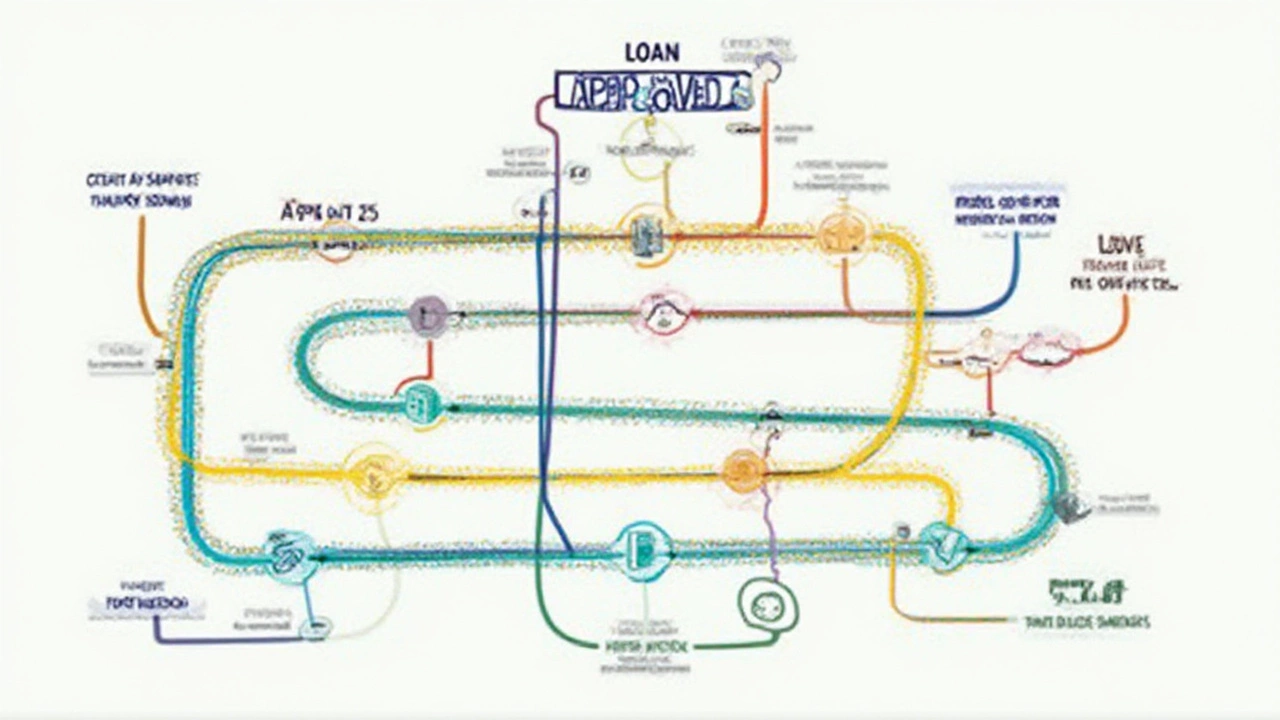Picture this: you check your phone, and your credit score flashes back at you—450. It feels like a final boss in the game of adulting. That number? Yep, it’s about as low as it gets. Getting a loan at this level sounds impossible, right? But here’s a little secret: low credit doesn’t mean zero options. The key is knowing where to look—and what to expect.
What a 450 Credit Score Means for Borrowers
Let’s break it down. A credit score of 450 lands you deep in the “poor credit” category, and most scoring models, like FICO or VantageScore, range from 300 to 850. Lenders view a 450 as a big red flag, usually because it signals missed payments, high debts, collections, or even bankruptcies. Basically, your credit history tells a lender you’re a risky bet. According to Experian’s 2024 Credit Review, only about 3% of Americans have a score below 500. So, if you’re here, you’re not alone, but you’re definitely in the bottom percentile.
Traditional lenders like major banks and credit unions set the bar high. Generally, you’ll need at least a 580—or, for some loans, 620—to even get considered. But before you throw your hands up in defeat, things are, surprisingly, not hopeless. There’s a niche world of lenders who specialize in high-risk loans.
You’ll need to prep for a tough ride, though. Lenders who work with poor credit borrowers often attach sky-high interest rates and strict repayment terms. Why? They need to offset their risk. The average APR for a subprime personal loan (under 600 credit score) in the U.S. hovered between 25% and 36% as of early 2025. Miss a payment, and you could watch fees snowball. Short loan terms are common too—think 6 to 24 months—which makes for high monthly payments. It’s kind of like renting money on a credit card but without any of the perks.
Moral of the story: a 450 credit score means you need to be strategic. You’ll have fewer options and face harsher terms, so it’s smart to ask yourself why you need the loan, whether you can wait, and what your realistic payback plan is.
Loan Options for People with 450 Credit Scores
So what lenders are even willing to talk to someone with a 450 score? Forget big banks for now—they usually rely on strict, automated checks, and your numbers will get you an instant "no." But not everyone slams the door shut that fast.
Subprime lenders focus on borrowers with poor credit. Online lending platforms such as OppLoans, NetCredit, and OneMain Financial have made a business out of high-risk loans. You might find payday lenders or title loan companies closer to home, but watch out—those come with interest rates that can reach 400% APR. Legitimate installment loan lenders (the kind you repay in set monthly amounts) are a much safer bet, even though their interest is still pretty steep.
Some lenders might ignore your score outright if you offer collateral. Secured personal loans, where you offer up an asset like a car or savings account as a safety net, can help lower-risk in the lender’s eyes. Of course, if you miss payments, you risk losing whatever you put up for collateral, so only go this route if you’re confident with your repayments.
Many credit unions—especially community-based or employer-affiliated ones—are a wild card here. They might consider more than just your credit history and focus on your income and ability to pay bills. Some even have "credit-builder loans" designed specifically for people starting over. These work the other way—first, you pay small monthly amounts into a savings account, and only get the money at the end of the term, with the bonus of improved credit if you’ve paid on time.
Personal loans from friends or family can also work if you set up clear repayment terms. Just be upfront and honest, and maybe even write out a contract. It keeps everyone on the same page, and believe me, a handshake alone rarely survives Thanksgiving dinner if payments go bad.
Online lending marketplaces, like LendingTree and Credit Karma, will sometimes pre-approve borrowers with low scores and match them to lenders. Don't get too excited by pre-approval, though—it usually means they’ll let you fill out an application, not that you’ll be approved for the amount you want.
If your paycheck is steady, employers in certain industries occasionally offer small-dollar loans or advances on your next check, bypassing credit completely. Just remember, these are usually deducted directly from your salary, which can make your budget extra tight the next month.

How to Improve Your Loan Approval Chances
Getting approved with bad credit isn’t about luck—it’s about stacking the odds. Start with proof of steady income. Lenders care about your ability to pay each month way more than the skeletons in your past credit closet. Bring pay stubs, recent tax returns, or even proof of government benefits to beef up your application.
Consider a co-signer—someone with good credit willing to vouch for you. Their signature can make even the most conservative lender give you a second look. Of course, if you default, your co-signer’s credit takes a hit, so don’t go this route lightly.
Double-check your credit report for errors. It’s not rare to spot accounts that don’t belong to you or payments improperly marked as late. Dispute any errors you find—just one fix might bounce your score up by 20, 40, or even 60 points in a month or two. You can check your credit for free every week at AnnualCreditReport.com (a real government-mandated website, no tricks).
Pay down balances if you can, especially on credit cards or open lines of credit. Utilization—the percentage you owe versus your total available credit—makes up about 30% of your score. Bringing balances below 30% of your limit can give your score a quick lift.
Applying for a smaller loan amount sometimes helps too. Lenders are more likely to approve, say, $500 or $1,000 over $5,000, because it presents way less risk. Later, if you make payments on time, you unlock bigger loans at better rates.
To boost your odds, prepare a budget showing exactly how you’ll keep up with payments. This tiny step surprises lenders—most people never do it—and it makes you look responsible and serious about paying the loan back. Some even accept a letter explaining your situation if your credit collapsed due to job loss, illness, or divorce; real lenders know that bad things sometimes happen to good people.
The Risks and Costs of Loans with Bad Credit
Let’s be real—borrowing money with a credit score of 450 is expensive. Most loans you’ll find come with interest rates high enough to make your head spin. A $1,000 loan at 36% APR for a year means more than $200 in interest alone. Borrow more or take longer to pay it back, and those costs multiply.
Payday loans sound simple but trap you in a cycle of debt. Did you know over 75% of payday loan borrowers roll over their balance at least once, often paying several times the original amount in fees? Title loans are even riskier—you could lose your car over a few hundred dollars if you hit a rough patch.
Watch for scams. If a lender asks for an upfront “processing fee” or guarantees approval regardless of your credit, it’s a major red flag. Stick with lenders who are transparent about fees and legal in your state. It’s smart to check with your state’s attorney general or banking commissioner website to confirm if a lender is registered to operate locally.
Most bad credit loans are reported to the credit bureaus. That means missing a payment will not only set you back with extra fees but can drive your score even lower. If you pay on time, though, it helps rebuild your credit in the long run, turning this high-cost chapter into a stepping stone.
Remember the golden rule: never borrow more than you can afford to pay back. Short-term solutions can create long-term headaches if you end up falling behind. Always read the fine print—some lenders hide prepayment penalties or extra fees. If anything’s unclear, ask for details or get a second opinion before signing on the dotted line.

Smart Alternatives: Building a Stronger Credit Future
Maybe your loan application hits a wall, or maybe you realize the offers on your table are just too risky. Either way, there are smarter ways to move forward. One powerful move: start small with a secured credit card or a credit-builder loan for just a few hundred bucks. Put something in your name, make on-time payments, and watch your credit climb month after month.
Deal directly with your creditors before you borrow money. If you need a loan for medical bills or utilities, many providers have hardship programs, zero-interest plans, or will take smaller payments in installments without ever checking your credit. Utility companies, hospitals, and even landlords are shockingly more flexible than you might think if you simply call and ask to negotiate.
If payday is too far away, consider pawning something meaningful before hitting the fast cash places. Pawnshops give you cash up front, and you can buy your item back when you get paid—with lower rates than most payday lenders. It’s not glamorous, but it’s a lot safer for your finances.
Seek out local nonprofits and credit counseling services. Organizations like the National Foundation for Credit Counseling (NFCC) set up free or low-cost budgeting advice and, in some cases, can help you access emergency loans or grants that don’t attack your credit.
Commit to small steady fixes now: pay at least the minimum on every bill, never bounce a check, and avoid opening new credit lines unless absolutely necessary. If you want the fastest route out of a 450 score, use free online tools to monitor your progress and target specific credit mistakes—aim for one fix per month, and watch how fast your report changes.
The bottom line? Getting a loan at 450 is tough, but not impossible. It’s a matter of careful research, honest assessment, and being clear-eyed about the risks. Use any cash you borrow wisely, keep laser-focused on payments, and see this as a pit stop—not the destination. One step at a time, and that score will inch higher, opening up better doors next time you need financial help.
